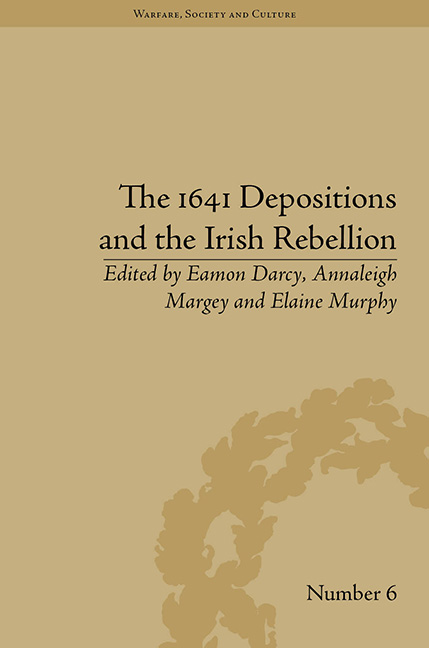Book contents
- Frontmatter
- CONTENTS
- Dedication
- Acknowledgements
- List of Contributors
- List of Figures and Tables
- List of Abbreviations
- Preface
- Introduction
- Part I The Outbreak of the Rebellion
- Part II Social Aspects of the Rebellion
- Part III Political and Military Aspects of the Rebellion
- 9 ‘Holy War’? Religion, Ethnicity and Massacre during the Irish Rebellion 1641–2
- 10 Siege of Duncannon Fort in 1641 and 1642
- 11 1641 and the Shaping of Cromwellian Ireland
- 12 The Trial of Lord Maguire and ‘Print Culture’
- Conclusion: The Rebellion in Text and Context
- Notes
- Index
10 - Siege of Duncannon Fort in 1641 and 1642
from Part III - Political and Military Aspects of the Rebellion
- Frontmatter
- CONTENTS
- Dedication
- Acknowledgements
- List of Contributors
- List of Figures and Tables
- List of Abbreviations
- Preface
- Introduction
- Part I The Outbreak of the Rebellion
- Part II Social Aspects of the Rebellion
- Part III Political and Military Aspects of the Rebellion
- 9 ‘Holy War’? Religion, Ethnicity and Massacre during the Irish Rebellion 1641–2
- 10 Siege of Duncannon Fort in 1641 and 1642
- 11 1641 and the Shaping of Cromwellian Ireland
- 12 The Trial of Lord Maguire and ‘Print Culture’
- Conclusion: The Rebellion in Text and Context
- Notes
- Index
Summary
Siege warfare dominated the military landscape of Ireland between 1641 and 1653. In a military manual based largely on his experiences in the period, Roger Boyle, earl of Orrery, summed up the situation when he wrote ‘we make war more like foxes than lions and you will have twenty sieges for every battle’. A number of factors account for the preponderance of sieges. The presence of a large number of fortified houses and castles throughout the country provided places of safety into which many Protestants fled after the outbreak of the rebellion in October 1641. The rebels could not leave these outposts in their midst. The large body of contemporary accounts of sieges that survive make it possible for historians to investigate many aspects of this type of warfare such as the spread of the military revolution to Ireland, tactics used by the defenders and attackers and the logistics of beleaguering different types of strongholds. These vary from descriptions of the storming of Drogheda and Wexford in 1649 to relations of more protracted campaigns at places like Youghal in 1645 and Bunratty in 1646. In taking the 1641 Depositions the commissioners collected a body of evidence that can be used to look beyond the alleged crimes and atrocities that took place to examine many aspects of life and society in mid-seventeenth-century Ireland. Given the twelve years of war that followed the rebellion it is hardly surprising that the 1641 Depositions contain a wealth of material about military affairs in Ireland. This ranges from graphic information about Irish attempts to manufacture saltpetre from Protestant corpses to more mundane details such as the names and ranks of soldiers in a company or regiment. A large number of deponents outlined their experiences of being besieged as the rebellion spread in 1641 and 1642 in places such as King John's Castle in Limerick or Long-ford Castle. By and large most depositions relate the experience of the siege from the point of view of the defenders. One of the best documented military engagements in the collection relates to the siege of Duncannon fort in County Wexford in 1641–2 and 1645.
- Type
- Chapter
- Information
- The 1641 Depositions and the Irish Rebellion , pp. 143 - 154Publisher: Pickering & ChattoFirst published in: 2014

